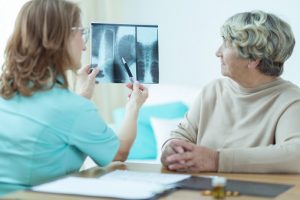 Celiac disease increases the risk of osteoporosis and bone fractures. The findings were presented at the EULAR 2011 Annual Congress, where researchers announced that celiac disease patients have a 4.5 times greater risk of developing osteoporosis, compared to healthy individuals of the same age and gender.
Celiac disease increases the risk of osteoporosis and bone fractures. The findings were presented at the EULAR 2011 Annual Congress, where researchers announced that celiac disease patients have a 4.5 times greater risk of developing osteoporosis, compared to healthy individuals of the same age and gender.
The study compared bone mineral density (BMD) loss in two physical locations in the body in 1,030 people. The researchers found that the lumbar spine BMD in celiac disease patients was significantly different in comparison to the control group. The femoral neck bone mineral density, however, was not found to be significantly different than the control group.
Advertisement
Mr. Oldroyd of Lancaster University School of Medicine said, “This is the first study that compares the extent of BMD loss at the lumbar spine and femoral neck in an age- and sex-matched cohort, and demonstrates that the detrimental effects of coeliac disease are most pronounced in the lower back compared to the hip joint. These findings may be due to the fact that the bone in the lumbar spine is spongy, less dense and weaker in comparison to the femoral neck, causing it to be more susceptible to the detrimental effects of coeliac disease. There is greater research required to determine why this effect is seen and whether it can have future implications for treatment.”
Celiac disease and the risk of osteoporosis, bone disease
Celiac disease is a condition in which the body’s immune system mistakenly attacks gluten, a common ingredient in wheat products, leading to symptoms like abdominal pain, constipation, and overall discomfort. The villi, which line the intestines and are necessary to absorb nutrients from the food that is being digested, become damaged when celiac attacks occur. When villi are damaged, the body cannot absorb essential nutrients, more specifically, those essential nutrients that the bones require to stay strong, thus contributing to weak bones and increasing the risk of osteoporosis.
The risk of osteoporosis further rises, the longer a patient goes without proper diagnosis. If celiac disease is diagnosed early on, treatment and changes to diet can take place in order to maintain bone strength. The longer the patient goes without diagnosis, the greater damage can occur to the villi, making it harder for the intestines to absorb nutrients.
It has also been suggested that osteoporosis may be a sign of celiac disease. Elderly patients who do not respond to typical osteoporosis medications should be treated for celiac disease.
Osteoporosis in celiac disease, prevention and treatment
 With celiac disease, the first step in treatment is embarking on a gluten-free diet. When gluten is consumed, that is when symptoms occur and damage the villi. Therefore, eliminating gluten can help reduce further damage, as well as better manage the symptoms. Furthermore, following a gluten-free diet also contributes to osteoporosis prevention, allowing for essential vitamins and nutrients to become absorbed in order to maintain proper bone health.
With celiac disease, the first step in treatment is embarking on a gluten-free diet. When gluten is consumed, that is when symptoms occur and damage the villi. Therefore, eliminating gluten can help reduce further damage, as well as better manage the symptoms. Furthermore, following a gluten-free diet also contributes to osteoporosis prevention, allowing for essential vitamins and nutrients to become absorbed in order to maintain proper bone health.
Osteoporosis can also be treated mainly with medications that help to prevent bone loss. Vitamin D and calcium supplements are often recommended in order to keep bones strong.
Advertisement
As long as celiac patients stick to their gluten-free diet, they can better protect themselves not only from the symptoms and complications associated with celiac disease, but also lower their risk of osteoporosis and bone fractures.
Celiac disease, osteoporosis management strategies
In some cases, a gluten-free diet is not enough to improve celiac disease outcomes. There are other useful management strategies which patients can embark on in order to better reduce their risk of osteoporosis and improve their care for celiac disease. Below are some management strategies for celiac disease and osteoporosis.
- Consume a diet high in calcium and vitamin D. These vitamins and minerals can be found in dark leafy greens, dairy products, egg yolks, saltwater fish, liver, and fortified foods like cereals and pasta (there are endless gluten-free varieties now available).
- Exercise is also important, as it helps to keep bones strong. Weighted exercises and strength training are essential for bone health. When we lift heavy weights, we cause small breaks in the bones that make the bones stronger when they heal. If lifting weights isn’t your thing, perform exercises that have impact to them, like dancing, walking, or running.
- Embark on a healthy lifestyle, like not smoking, minimizing alcohol consumption and coffee intake. These factors have been shown to weaken bones overtime, and smoking specifically has been found to lead to early menopause, reducing estrogen sooner and contributing to weaker bones.
- Get a bone density test and know your numbers. A bone density test can be done on different bones in the body, so you can find out which areas are weaker.
- Medications are available to prevent and treat osteoporosis – speak to your doctor about any bone health concerns to see what is available to you.
Osteoporosis does not have to be an inevitable part of celiac disease. Even though the risk may be higher, you can take necessary steps in order to lower that risk and better manage both diseases in order to avoid complications.
